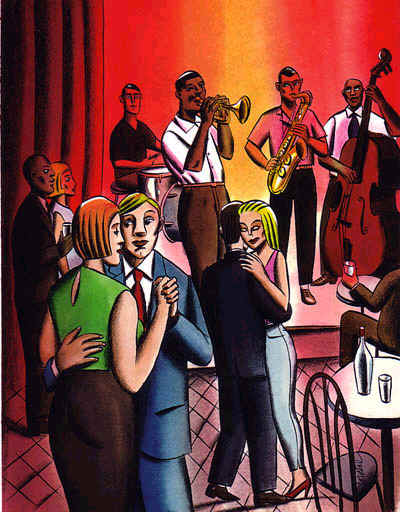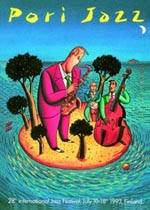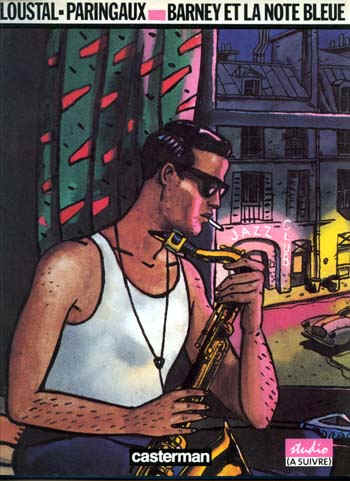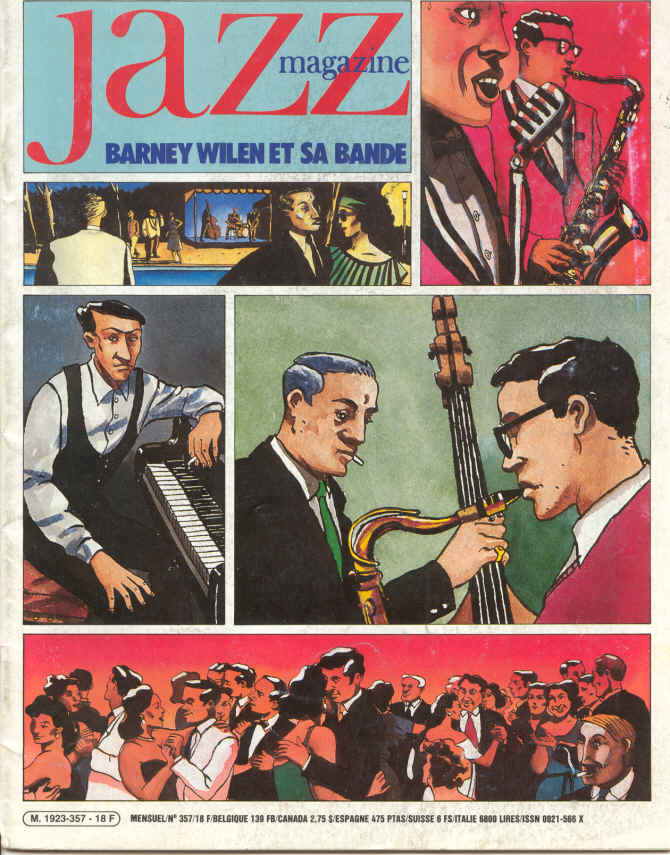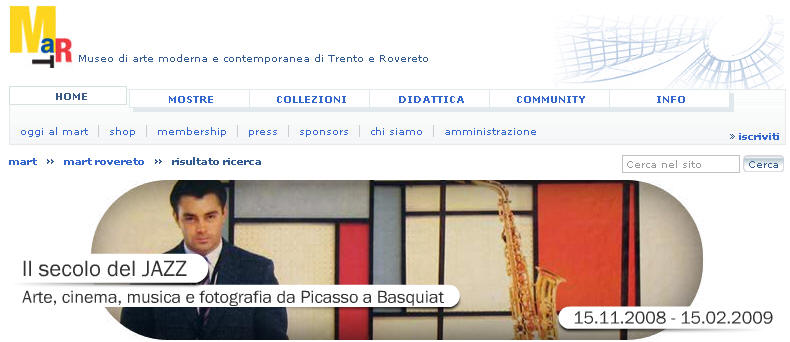Ascolta la recensione de "Il Secolo del jazz" di Henning Kluever per la Bayerischer Rundfunk (in tedesco). O scarica il pdf
2009 "Le Siècle du Jazz"
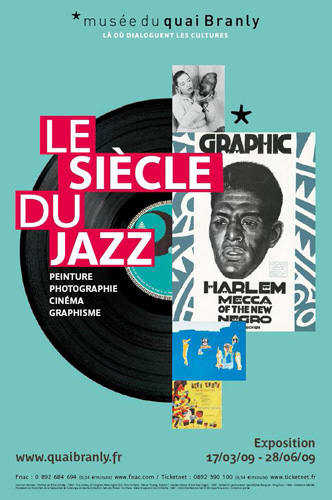
l'exposition "Le Siècle du Jazz", présentée au musée du quai Branly du
17 mars au 28 juin 2009.
http://www.quaibranly.fr
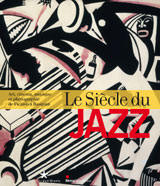
[Exposition. Trento. Rovereto, Museo di arte moderna e contemporanea di
Trento e Rovereto. 2008/2009]
Le siècle du jazz [Texte imprimé] : art, cinéma, musique et photographie de
Picasso à Basquiat : [exposition, Rovereto, Museo di arte moderna e
contemporanea di Trento e Roverto, 15 novembre 2008-15 février 2009, Paris,
Musée du quai Branly, 17 mars-28 juin 2009, Barcelone, Centre de cultura
contemporània, 21 juillet-18 octobre 2009] / [organisée par le Museo di arte
moderna e contemporanea di Trento e Rovereto, le Musée du quai Branly et le
Centre de cultura contemporània de Barcelone] ; [catalogue] sous la
direction de Daniel Soutif. - Paris : Musée du quai Branly : Skira
Flammarion, DL 2009 (impr. en Italie). - 1 vol. (446 p.) : ill. en noir et
en coul., couv. ill. en coul. ; 29 cm.
Contient des trad.. - Bibliogr. p. 435-439.
ISBN 978-2-08-122424-7 (br.) : 49,90 EUR. - EAN 9782842786779.
Jazz -- Dans l'art -- Catalogues d'exposition
Jazz et cinéma -- Catalogues d'exposition
Jazz -- Histoire et critique -- Catalogues d'exposition
Le siècle du jazz
art, cinéma, musique et photographie de Picasso à Basquiat
Exposition. Paris, Musée du quai Branly (2009)
dirigé par Daniel Soutif
Editeur : Skira-Flammarion
Date de parution : 11/03/2009
Thème : Beaux-arts Art Esthétique
ISBN : 978-2-08-122424-7
Gencod : 9782081224247
Format : 24 x 28 cm
Nb de pages : 446
Prix : 49,90 EUR
Epopée du genre musical, né au début du XXe siècle, illustrée par différents
arts : peinture, photographie, mais aussi graphisme et bande dessinée. Avec
notamment les oeuvres de Picabia, Man Ray, Matisse, Pollock, Loustal etc.
Le jazz constitue, avec le
cinéma et le rock, l’un des événements
artistiques majeurs du XXe siècle. Cette musique hybride, née
dans les premières années de ce siècle, l’a traversé en marquant
chaque aspect de la culture mondiale de ses sons et de ses rythmes. Plus
qu’un simple genre musical, le jazz a non seulement révolutionné la musique,
mais a également initié une nouvelle façon d'être dans la société du XXe
siècle qui a profondément
influencé l'histoire de l'art du siècle dernier.
Le Siècle du jazz invite le public à comprendre, sur près de 2000 m2
d’espace d’exposition, combien la bande-son du jazz a coloré tous les autres
arts, de la peinture à la photographie, du cinéma à la littérature,
sans oublier, les arts graphiques, la bande dessinée et les dessins animés.
Elle offre une lecture pluridisciplinaire et vivante de l’histoire complexe
de cette musique à travers dix sections chronologiques et près de 1000
oeuvres : objets et documents, partitions illustrées, affiches, disques et
pochettes, photographies, audiovisuels, etc.
La variété des nombreux documents présentés témoigne de la diversité des
disciplines touchées par le phénomène Jazz : des toiles de Léger, Pollock,
Dubuffet, Basquiat ou Bearden côtoient des photographies de Man Ray, Carl
Van Vechten, Jeff Wall, ou d’artistes moins connus en Europe. Des
exemplaires de la revue Survey Graphic, des pochettes des labels Columbia ou
Atlantic, des bande dessinée de Loustal ou Guido Crepax, une installation de
David Hammons Chasing the blue train, près de 40 sources sonores dont des
enregistrements du célèbre Strange fruit de Billie Holiday, repris notamment
par Maria Schneider. Une salle dédiée au cinéma présente de nombreux
extraits de films tels que Begone Dull Care un film abstrait de Norman Mac
Laren, Ascenseur pour l’échafaud de Louis Malle, ou encore Jammin' the Blues
de Gjon Mili (1944) projeté dans son intégralité.
Il Secolo del Jazz
-Il Secolo del Jazz- e' in programma al Mart di Rovereto dal
15 novembre 2008 al 15 febbraio 2009.
www.mart.tn.it/
Musée du Quai Branly Announces "The Jazz Century Exhibition"
PARIS.- Jazz, along with cinema
and rock music, constitutes one of the major artistic developments of the
20th century. Born at the beginning of that century, this musical hybrid
marked every aspect of world culture with its sounds and rhythms. More than
a simple musical genre, jazz not only revolutionized music but also
introduced a new way of life in 20th century society, which has deeply
influenced the history of art of the last century.
With nearly 2,000 m2 of exhibition space, The Jazz Century invites the
public to see to what extent the soundtrack of jazz has influenced the other
arts, of painting, photography, cinema and literature, not forgetting the
graphic arts, comic strips and animated cartoons. It offers a
multidisciplinary and lively reading of the complex history of this music
through ten chronological sections and nearly 1,000 works; objects and
documents, illustrated musical scores, posters, records and sleeves,
photographs, audiovisuals, etc.
The variety of the numerous documents shown bears witness to the variety of
disciplines affected by the Jazz phenomenon: paintings by Léger, Pollock,
Dubuffet, Basquiat or Bearden mixed with photographs from Man Ray, Carl Van
Vechten, Jeff Wall and lesser known European artists. The exhibition
includes copies of the Survey Graphic review, Columbia and Atlantic label
covers, comic strips by Loustal and Guido Crepax, Chasing the Blue Train, an
installation by David Hammons, nearly 40 sound sources, including the famous
Strange Fruit by Billie Holiday, notably revived by Maria Schneider. A room
devoted to the cinema presents numerous film extracts, such as Begone Dull
Care, an abstract film by Norman Mac Laren, Ascenseur pour l’échafaud (Lift
to the Scaffold) by Louis Malle and even Jammin' the Blues by Gjon Mili
(1944) shown in its entirety.
The Century of Jazz, shown at the musée du quai Branly offers a new
perspective on a section of African American art, a specific aspect of
American culture still little known on this side of the Atlantic and which
has resulted in numerous artists being shown in the exhibition.
A history of jazz, a red thread guides us through the century
The exhibition is chronologically based around a red thread consisting of a
timeline, a large showcase, 50 metres long, which follows year on year, the
main events of the history of jazz. The numerous music scores, posters,
records, reviews and magazines, books, photographs, films, animated cartoons
and recordings exhibited remind the visitor of the marked episodes of this
era.
The timeline takes us from Nobody by Bert Williams (1905) or Some of These
Days by Sophie Tucker (1910;, successes which preceded the appearance of the
mysterious « jazz » term, to the concerts at the Lincoln Centre or to the
young «Downtown» generation of New York and numerous records and historic
concerts, not forgetting the first ever jazz recording by the Original Di
xieland Jazz Band in 1917. Punctuated by sound and audiovisual sources, this
timeline guides visitors, leading them from room to room. The music clips
played in a chronological order, serve as stages one encounters one after
the other.
Thematic rooms
A large number of thematic rooms (Harlem Renaissance, The Swing Years, Bebop,
The Free Revolution, etc.) all along the timeline, highlight the
relationship of jazz with other artistic disciplines and also relate to the
history of the century following the sequence of events of this musical red
thread. The distinctness of the stands shown on the timeline particularly
reflects the abundance of creation generated by jazz, from the illustrated
album covers by masters of the genre such as Alex Steinweiss or Lee
Friedlander, to the contemporary videos by Adrian Piper, Christian Marclay,
Lorna Simpson or Anri Sala.
THE EXHIBITION
The exhibition is based on ten chronological sections linked together by the
timeline showcase which follows the exhibition in the form of a long
chronological fresco. This fresco is the red thread of the exhibition, which
follows sections, which are themselves divided into thematic or monographic
rooms:
PRE-1917
It is obviously impossible to fix a precise date for the birth of jazz. 1917
is nevertheless considered as crucial because of the combination of two
decisive events. In February, the Original Dixieland Jazz Band, with its
white musicians, made their first recording under the Jazz label (or to be
more exact, Jass). In November, the American army closed down the red-light
district of Storyville in New Orleans, whose famous establishments had
employed a number of musicians, the majority of whom emigrated to the north
of the United States and in particular to Chicago and New York. One has to
be careful, however, not to overlook numerous earlier signs – minstrels,
coon songs, cake-walk, ragtime, etc. – which announced the musical
phenomenon which was about to dramatically change the century and inspired
numerous artists well before this date.
« THE JAZZ AGE » IN AMERICA 1917-1930
In the United States, the First World War was followed by a fantastic craze
for jazz music, as can be seen in F. Scott Fitzgerald’s book Tales of the
Jazz Age in 1922. The fashion was such that the expression coined by
Fitzgerald, came to describe this whole period, a generation of “children of
jazz” and no longer purely the sound track to the era.
In addition to the marvellous illustrations that decorated the music scores
of hit songs, the jazz age can be seen in the photographs taken by Man Ray
during this period (in particular the one entitled Jazz in 1919) and
numerous other works by American artists such as Arthur Dove and James
Blanding Sloan or individuals such as Miguel Covarrubias and Jan Matulka,
who were living in the United States.
HARLEM RENAISSANCE 1917-1930
Whilst white Americans were living their Jazz Age, African Americans for the
first time in their history reached true cultural recognition with the
movement later called the Harlem Renaissance. If the jazz of Louis Armstrong
or Duke Ellington was certainly one of the major components of this creative
effervescence, the music was nevertheless far from being the only aspect.
Under the leadership of key figures such as the writer Langston Hughes or
the painter Aaron Douglas, a number of artists produced flourishing
masterpieces, as much literary as visual, for whom the music was far more
than just a pet subject. It also important to remember the significant role
played in this mainly black movement by white artists such as Winold Reiss
or Carl van Vechten.
« THE JAZZ AGE » IN EUROPE 1917-1940
James Reese Europe’s infantry band, the Harlem Hellfighters, arrived in
France during the First World War and introduced new syncopated rhythms to
Europe. With the end of hostilities, the Jazz craze quickly took over all
aspects of the culture of the old continent. The arrival in Paris in 1925 of
the Revue nègre with Josephine Baker crowned the invasion of this Tumulte
noir, so nicknamed by Paul Colin in his famous portfolio. From Jean Cocteau
to Paul Morand, Michel Leiris or George Bataille, countless writers were
inspired in one way or another by this tidal wave. The phenomenon was no
less appreciable in the field of the visual arts, from Marcel Janco to Kees
Van Dongen, Pablo Picasso, Otto Dix or Fernand Léger.
THE SWING YEARS 1930-1939
Following on from the jazz age came Swing, a dance evoked during the
explosive years of the thirties by the performances of important black bands
with Duke Ellington and Count Basie or white bands such as those led by
Bennie Goodman, Tommy Dorsey or Glenn Miller. When sound came to the cinema,
numerous musical comedies bore witness to this new fashion and its appealing
syncopated beat, which equally inspired many artists. In the United States,
the modernist painter Stuart Davis and the regionalist Thomas Hart Benton
shared the same interest in music. Whilst in Europe, Frantisek Kupka
dedicated several paintings to this type of jazz that experts such as
Charles Delaunay d escribed as “Hot” in order to set it apart from its
sweeter offshoots. An event would take place at the end of this decade that
would prove to be decisive: Alex Steinweiss, then a young unknown artist,
would design the first record cover for Columbia Records.
TEMPO OF WAR 1939-1945
The Second World War had a dramatic impact on world culture. Whilst music,
thanks to the V-discs produced by the American army, accompanied soldiers on
to the battlefields, the calamity did not slow down jazz repercussions in
other artistic fields. Piet Mondrian had no sooner arrived in New York than
he discovered the Boogie Woogie, which would determine the essential style
of his final masterpieces. William H. Johnson paid tribute to the popular
steps of the Jitterbug. Simultaneously in Paris, the Zazous, probably so
called because of a piece of music by Cab Caloway, were known for their
eccentric attire – the Zoot Suit!- which although hardly risky, ironically
demonstrated their opposition to the invaders. Paradoxically, jazz was
enjoying great popularity in France at this time, which perhaps explains the
interest of Jean Dubuffet or Henri Matisse who, took up his scissors and cut
some coloured paper from which he created his famous work Jazz.
BEBOP 1945-1960
With Bebop, which sprang up at the end of the war, jazz in turn became
modern, whilst in painting, abstract expressionism was getting ready to show
its first colours. Some of these protagonists, Jackson Pollock in particular,
found direct inspiration from the jazz music that he was listening to all
the time. In Europe, Renato Guttuso, Antoni Tapiès and Nicolas de Staël,
also found in jazz a subject for their painting. A new artistic field, which
appeared with the microgroove record, was the record cover. Some dozens of
graphic artists, both famous and unknown, from David Stone Martin to Andy
Warhol, Josef Albers to Marvin Israel, Burt Goldblatt to Reid Miles, devoted
themselves to the task of the seduction of music lovers in a rigorously well-defined
format : 30 x 30 cm. And lastly, cinema did not escape the influence of
modern jazz. Amongst the dozens of films that remind us of this are
Ascenseur pour l’échafaud (Lift to the Scaffold) by Louis Malle or La Notte
(The Night) by Michelangelo Antonioni.
WEST COAST JAZZ 1949-1960
The commonly accepted history of jazz thinks of Bebop as being mostly black
and New York-based, whilst the typical image of the west coast; within range
of the Hollywood studios, is assumed to be white and fresh – cool even – and
smooth and sophisticated. In reality, despite a more agreeable climate and
great subtlety, West Coast jazz could rival New York in personality and
energy. Nevertheless, the typical graphic design of the record labels
clearly reflects the difference between the two American coasts. Strong
geometric lettering and pictures and close-ups of black musicians to the
east, sunny beaches and pretty blondes twirling by the sea to the west…
These holiday images nevertheless should not distract from the fact that
California was also one of the favoured placed for encounters between jazz
and poetry, beloved of the Beat Generation.
THE FREE REVOLUTION 1960-1980
Ornette Coleman recorded Free Jazz in 1960. With its double entendre title–
Free jazz! or Free jazz – this record whose cover shows a reproduction of
White Light by Jackson Pollack, marks a new order: after the modern period
came this libertarian avant-garde. The visual arts responded to this
contemporary free revolution of black liberation movements – Black Power,
Black Muslims, Black Panthers, etc. –this is reflected in the full maturity
of the work of artists such as Romare Bearden, newcomers such as Bob
Thompson, who lived too short a life, or in Europe, British Alan Davie.
Amongst the many effects of this upheaval, we must not forget Notes towards
an African Orestes, this rough draft of a film in which director Pier Paolo
Pasolini invited free improvisation by Gato Barbieri bringing Aeschylus to
Africa.
CONTEMPORARY PERIOD 1960-2002
The presence of jazz in the contemporary art scene, if not always obvious,
is far from negligible; as witnessed by the richly layered works of Black
Music by Jean Michel Basquiat or those of his senior, Robert Colescott. In
their own, very different, way, videos by Adrian Piper, Christian Marclay,
Lorna Simpson and Anri Sala equally confirm this presence in the same way as
the Prologue by Canadian artist Jeff Wall, whose inspiration came from Ralph
Ellison’s great novel, the Invisible Man. Finally, the little blue train of
David Hammons, running through the coal hills, and the piano-lids conceived
by this legendary African American artist serves as a conclusion to the
exhibition: if the 20th century, that Century of Jazz, is well and truly
over, the train of music that accompanied it is itself, still in motion.
|
|
|
Il Secolo del Jazz
|
